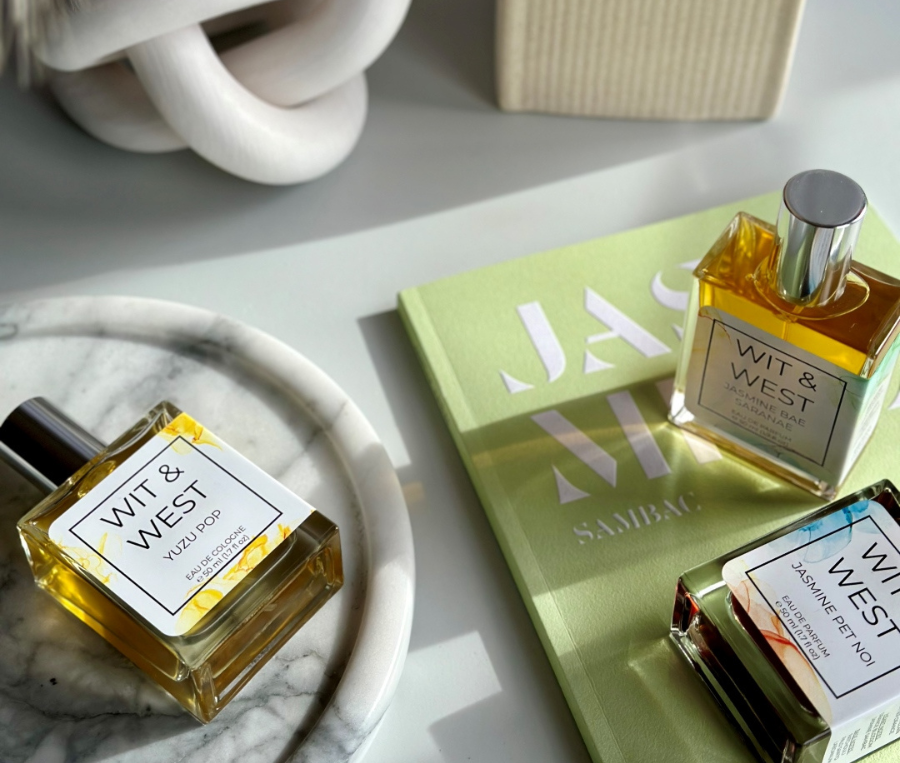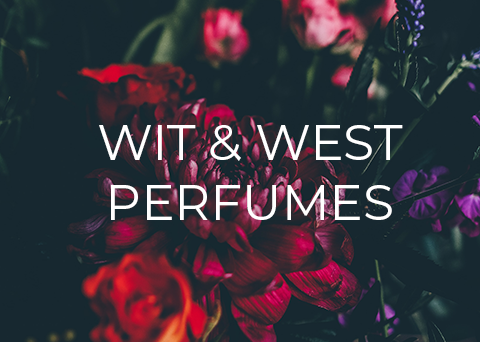Cologne vs. Perfume: What's the Difference?

Photo Credit by Wit, Owner & Perfumer for Wit & West Perfumes (Photo of Yuzu Pop Eau de Cologne, Jasmine Bae Sarane Eau de Parfum, and Jasmine Pet Noi Eau de Parfum)
Understanding the Difference Between Cologne vs. Perfume
The world of perfume can be confusing, especially when there is conflicting information regarding definitions and categorization in perfume. For example, one of the common misconceptions around fragrance is related to cologne vs. perfume, and that cologne is for men while perfume is for women. There are some things we should unpack on this topic, including fragrance styles, concentration levels, and gender in fragrance, but first, let us start with a bit of history and a definition of each of these words.
Perfume History & Definition
The word perfume is derived from the Latin word “per fumus”, which translates as “through smoke.” Perfume has a long history as the art and craft of perfume-making evolved over 5,000 years. Historically speaking, perfume has roots in medicinal, social, and religious uses. The first uses of perfume can be traced back to Ancient Egypt, Mesopotamia, and Cyprus, where perfumes were blended with aromatics and rare raw materials such as resins, oils, and fragrant herbs (Morris, 1984). Traditionally, perfumes were blended at a higher concentration level and thus considered to be longer lasting. The word perfume is defined as a substance that emits and diffuses a pleasant and fragrant odor, aka fragrance. Today, in the fragrance industry, there are different fields of focus, including fine fragrance and functional fragrance. In fine fragrance, the sole purpose of the product is the scent itself, and the fragrance is blended with alcohol and sprayed directly on skin (such as an eau de parfum, eau de toilette, eau de cologne, etc.). In functional fragrance, the purpose of the product is to scent another product, such as hand soap, laundry detergent, shampoo, or lotion. In short, the word perfume is used as an overarching or general term for fine fragrances, which also includes cologne. For a deeper look at the history of perfumery, check out my blog topic on the history of perfume.
Cologne History & Definition
Cologne was named after the city, Cologne, Germany. In the context of fragrance, eau de cologne means “Water from Cologne” (also shortened to just cologne). While the name eau de cologne comes from the city of Cologne, Germany, the original formulation was created by an Italian barber named Giovanni Paolo Feminis, who left Italy to pursue other opportunities in Germany. In 1709, Feminis started marketing a highly distilled “water” fragranced with various herbs well-known to the Italian tradition. His Aqua mirabilis was made of highly rectified grape spirits, neroli, bergamot, lavender, and rosemary. While the reception for the product was well-received in Germany, Feminis decided to ask for a relative named Giovanni Maria Farina for assistance with the business. Farina, an Italian-born perfumer, took over the entire business and saw great success with the multi-purpose fragrant water, which eventually became known as the original eau de cologne (Morris, 1984). In a letter that he wrote to his brother, Jean Baptiste, Farina said he set out to make a perfume that reminded him of “…an Italian spring morning, of mountain daffodils and orange blossoms after the rain" (Farina). As an ode to his new hometown, he decided to name the fragrance after the city of Cologne. While the meaning of a fragrance that is labeled a cologne has somewhat evolved in terms of the fragrance style, concentration and who it is marketed to, traditionally eau de colognes were unisex and composed at a lower concentration at about 2-5% (percentage of fragrance concentration contained in a perfume; see next section for more details on this topic) with a greater focus on top notes at approximately 80% of the composition being comprised of top notes that are citrusy and fresh, 12% top to heart notes that are aromatic (lavender, rosemary), 5% heart notes that are floral (rose, jasmine) and 3% base notes that are woody (The NEZ Collective, 2020). You can find the Farina 1709 Eau de Cologne today, as it is still in production through the perfume house of the same name, Farina 1709.
Still confused about the difference between cologne vs. perfume? Let me summarize: perfume can be anything that has a pleasant or sweet-smelling fragrance that is sprayed directly on the skin. Cologne is a type of perfume and traditionally, the standard for cologne was based on not only a lower concentration (as compared to other fine fragrances such as an eau de parfum), but also on the ingredients or notes of the fragrance which were fresh, citrusy, herbal and floral (this isn’t always the case today which I will explain in the next two sections of this blog). But wait, there is still more to the story. Let us dig into concentration levels and how they differ based on the type of fragrance.
What is the Concentration Level in Perfume?
The term concentration in perfumery refers to the percentage of fragrance concentrate (e.g., essential oils, absolute oils, aroma chemicals) in the perfume vs. the alcohol base. While the concentration might vary by brand (at Wit & West, we are generally in between the listed range for an eau de parfum and a parfum for our eau de parfums, and for our eau de colognes, we are between the listed range for an eau de cologne and an eau de toilette), in general, the table below can serve as a loose guideline for understanding what you are getting based on the concentration that is listed on the bottle:
| Perfume Type | Concentration |
| Eau Fraiche | 1-3% |
| Eau de Cologne | 3-5% |
| Eau de Toilette | 5-8% |
| Eau de Parfum | 10-15% |
| Parfum | 20-30% |
| Extrait de Parfum | 30-50% |
| Attar | 100% |
Concentration Source: McCartney & Scriven, 2021
There are a few reasons why it is important to understand a perfume’s concentration, and I discuss these at greater length in my blog topic on how to find the perfect perfume. For this blog topic, it’s important to note that in general (but not always), the higher the concentration, the longer the fragrance will linger. To expand, an eau de cologne that follows the traditional structure of a larger percentage of top notes vs. heart and base notes, along with the overall fragrance concentration of between 3-5% will typically last on the skin about 1-2 hours. In contrast, an eau de parfum might last between 3-5 hours on the skin. Both of these guidelines are true in the Wit & West Perfumes line, as we have both fragrances that come in eau de parfum concentrations (see the Signature Collection and Reserve Collection) as well as eau de cologne concentrations (see the Cologne Collection).
Cologne vs. Perfume: Deconstructing the Role of Gender Norms in Perfumery
Gender in perfumery is a complicated topic that is rooted in history, culture, fashion, and gender roles in society. In general, we think of women smelling of flowers and men smelling of citrus, woods, and musk. But when and how did this distinction between genders occur? The distinction between men and women in perfumery started toward the end of the 19th century, and until about the early 1920s, most fragrances marketed towards men were unisex eau de colognes or lavender-centric fragrances, including the first fougère fragrance, Fougère Royale, created in 1882 (Morris, 1984). In the 1930s, the first fragrance marketed to men was created and was called Pour un Homme by Caron (which means “for a man” in French). Over time, the once blurred lines separated further as the perfume industry started to see growth in the men’s fragrance category in the 1960s. The term “cologne” became a catchall for men’s fragrances, while “perfume” was defined as being specific to women’s fragrances (regardless of the fragrance concentration itself).
Today, while the gender distinction of cologne vs. perfume is that “cologne” is for men and “perfume” is for women is still used colloquially in Western society, this trend has been shifting as consumers demonstrate a desire for personalization and choosing what suits them. In addition, some of the large brands (such as Byredo or Le Labo), as well as many independent and smaller perfume houses, have already adopted a focus on gender neutral or genderless specific fragrances. For myself and West, our view as owners of Wit & West Perfumes is that it is up to the individual’s preferences and as such, we don’t gender specify our fragrances other than to identify the fragrance concentration (currently, we offer 3 eau de colognes in our Cologne Collection as well as 10 eau de parfums in the Signature Collection and 3 eau de parfums in the Reserve Collection).
Tips for Choosing the Right Perfume for You
Now that you have a better understanding of the difference between cologne vs. perfume, including their origins, concentration levels, as well as the history of gender roles in perfumery, let us talk about how to find a new fragrance that is right for you.
- Look at the fragrance family or olfactive family, as well as notes in a perfume, and see what appeals to you (fragrance or olfactive families are the fragrance industry’s classification system based on olfactory characteristics; woody, floral, fresh/citrus, gourmand, amber, fougère, and chypre). A great resource that breaks down notes, fragrance families, specific perfumes, and more is The Perfume Society’s website: Perfume Families - The Perfume Society.
- Look at the concentration level listed on the perfume. If you are looking for something light, fresh, and great for everyday or daytime wear (e.g., at the office), you might want to opt for something like an eau de cologne or an eau de toilette rather than an eau de parfum or a parfum.
- Sample first before committing to a full-size bottle. It is always best to wear perfume a few times before you commit to a full-size bottle. These days, most brands offer individual samples on their website as well as sample sets (check out the Wit & West Samples page for our sampling options).
References
Farina, G. M. (n.d.). Eau de Cologne. Retrieved from Wikipedia: https://en.wikipedia.org/wiki/Eau_de_Cologne.
McCartney, S., & Scriven, S. (2021). The Perfume Companion: The Definitive Guide to Choosing Your Next Scent. London: Frances Lincoln Publishing.
Morris, E. T. (1984). Fragrance: The Story of Perfume from Cleopatra to Chanel. New York: Charles Scribner's Sons.
The NEZ Collective. (2020). The Big Book of Perfume. NEZ editions.

